
An Teallach:
Sail Liath, Stob Cadha Gobhlach, Corrag Bhuidhe, Lord Berkeley's Seat
Sgurr Fiona & Bidein a' Ghlas Thuill
Saturday 20th August 2011
Sail Liath, Stob Cadha Gobhlach, Corrag Bhuidhe, Lord Berkeley's Seat
Sgurr Fiona & Bidein a' Ghlas Thuill
Saturday 20th August 2011
 Weather/Conditions: Lots of rain and wind. A wild, wet day. Swirling winds on Corrag Bhuidhe gave moments of extreme wind followed by absolute calm. Cloud was above the summits over Sgurr Fiona, but closed in over Bidein a' Ghlas Thuill. The tramp back to the road was very wet.
Weather/Conditions: Lots of rain and wind. A wild, wet day. Swirling winds on Corrag Bhuidhe gave moments of extreme wind followed by absolute calm. Cloud was above the summits over Sgurr Fiona, but closed in over Bidein a' Ghlas Thuill. The tramp back to the road was very wet.
Distance/Ascent/Time: 15km / 1450m / 7h 50m
Accompanying: Bealach M. C. - Dougie, Craig and Tommy (Diane on walk-in)
The Forge
I first heard of An Teallach properly around 2008. I visited Wester Ross for a week in the most beautiful April weather, with cumulus piling into blue skies and snow on the mountains. That week will always be incredibly significant to me, as the first time I was thrust into a world of magnificent mountains that only served to contrast my life of exams and deadlines. I think many hillwalkers can relate to this feeling, but these mountains were at another level altogether. Back then I was aware of An Teallach and it's enormous reputation. My first view of An Teallach was of gullies and buttresses carved in sandstone and covered in snow that climbed into mist. The feeling of being utterly awestruck hasn't left me.
I knew of it's castellated pinnacles, the deep lochan and the great Toll (a corrie) which is surrounded by immense cliffs. An Teallach's attraction was in it's mystery, and yet it oddly repulsed me, too. I don't think any other mountain held me in fascination for so long. You can climb the Munros and safely omit the pinnacles, but that isn't really where the spirit of An Teallach lies.
An Teallach's true spirit is in it's magnificent Corrag Bhuidhe - the yellow fingers. These pinnacles look like fingers - organic in shape, they rise to an airy 1060m. Why they should be yellow escapes me. The true An Teallach lies above Toll an Lochain and the sweep of pinnacles. I find the names evocative, too: Sail Liath, Stob Cadha Gobhlach and Corrag Bhuidhe.
When Bealach M. C. organised a trip to The Smiddy, (JMCS-owned hut at Dundonnell), An Teallach was on the cards. And if you're staying in Dundonnell, it has to be The Forge.
Only, I'd only ever expected I would want to do it in good weather. The forecast for this weekend was not looking good and there were no guarantees in my head we would complete the traverse.
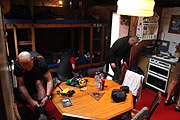
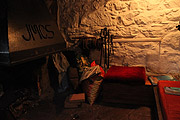
Past rowan and bog cotton
So five of us set off from the parking by Dundonnell House, following the track that leads to Shenavall. With the mist down on the summits, Craig and I pushed ahead to the moors. The wind was pretty atrocious, even lower down, but I was strangely calm about climbing An Teallach and I wondered why this was. It's often too easy to get uptight about a difficult or exposed section of a mountain, and An Teallach was not one to be taken lightly.
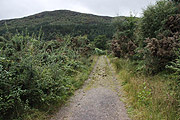
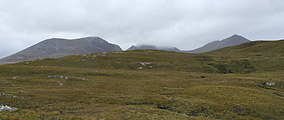
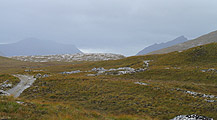
Four of us slogged up Sail Liath's arm (Diane turned back) and the highlight was the immense views east over the moors. They seemed utterly desolate today, although that was not a description of my mood. I was quite excited to be climbing An Teallach, although if we couldn't get over the pinnacles in this weather then much was at stake: two Munros and a direct route back to the Smiddy.
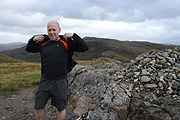
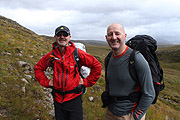
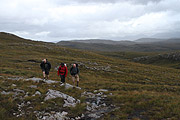
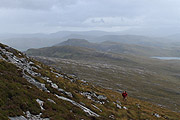
The wind just kicked up to greater speeds as we walked to the top of Sail Liath. We met walkers coming down - they were all coming down - and they'd all turned back. What was it like up there? We arrived at Sail Liath and carried on past the cairns. We saw no reason to turn back, although the other teams evidently thought it too rough. Beyond, the precipices danced through mist - a dynamic day if there ever was one. A 915m pinnacle lies between Sail Liath and Stob Cadha Gobhlach and it's is one of the examples of An Teallach's 'organic' weathering. It presents a steep profile from the corrie below, but it's an easy addition to the traverse.
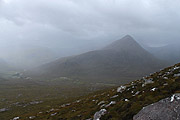
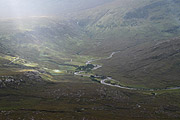
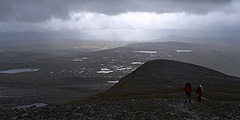
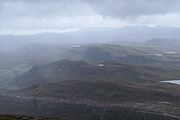
Michael (Coffield) described Stob Cadha Gobhlach something like a 'disintegrating pile of sand'. When I climbed it, I saw what he meant. Interestingly, I remember hearing the 'Stob' in the name is likely a modern addition, illustrated by the absence of Stob's in this region of Scotland. I digress. The others bypassed the summit, I ticked off the top and we carried on with the formidable - incredible - Corrag Bhuidhe. The winds were high, the rain was lashing through periodically and we were all wondering how things would pan out. We enjoyed a gully-with-the-chockstone then started the long ascent onto the pinnacles.
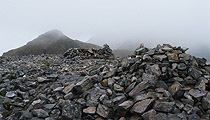
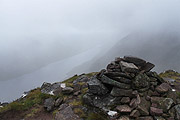
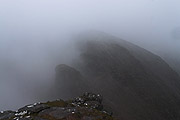
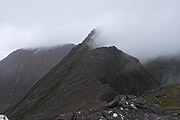
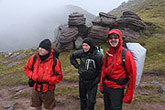
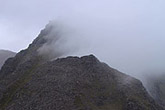
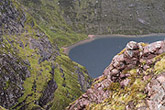
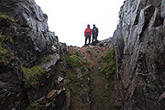

Yellow Fingers
The Yellow Fingers was the part I always wondered about. If any part had frightened me the most, it was that long climb northward up to the pinnacles. The pinnacles themselves I weren't so concerned about; the long exposed slopes to the crest I was absolutely was. It was the exposure and fall potential that was frightening. This buttress looks incredible in photographs and here I was today, in weather anything but perfect.
But I wasn't anxious now. Rather, I looked forward to solving the problem of the Corrag Bhuidhe.
Once on par with the pinnacles, we quickly discounted taking the direct route to the top. It is barred by many awkward sandstone slabs, and today the rock was greasy and slippery. The drop on our left was killer, we would rather walk away alive than try climbing exposed rock. So we started following the bypass paths on the more amenable left hand side. The drops here are spectacular, but not so life threatening. I certainly didn't feel frightened on them. Here, the mountain feels much like Stac Pollaidh with steep sandstone outcrops and little paths snaking lines through the rubble.
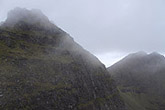
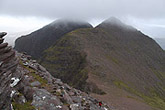

We would try one path, only to find it running out. We took another path higher up; it ran out too. Then we climbed higher and veered back onto the crest of the ridge - it was only a reminder to keep away from the edge toward Toll and Lochain! That is one lethal cliff! The feeling of exposure is magnificent. Above, the vertical/overhanging buttress of Corrag Bhuidhe remained. We couldn't climb it direct, but we had to get past it somehow... The rain was falling, the wind screamed over the crest. But I was calm and enjoying the experience. It was not how I'd expected An Teallach to be.
So we took a bypass on the right hand side again. I was certain we'd taken this path before, but it continued further than previously. And then a path appeared on our right that climbed a steep gully toward the ridge crest. I climbed up and Craig stood below until I shouted back that it "felt safe" (for now!) And it continued feeling safe until in an instant - I was on top of Corrag Bhuidhe! Wow!
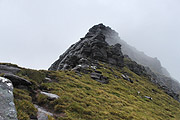

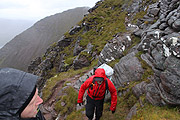
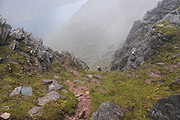
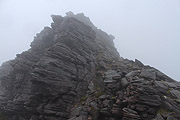
You could almost walk up Corrag Bhuidhe by this path - if you knew where to look. There is a path pretty much the whole way, but don't count on finding it too easily. It would be easier to find on descent, but it was surprising to discover you could almost traverse An Teallach hands in pockets!
We took the little bypass path underneath the bristly crest of Corrag Bhuidhe. I will climb that magnificent highway in cool dry rock, but for today it was a no-go zone. The 500m down to Loch Toll and Lochain just isn't worth it.
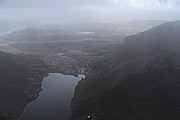
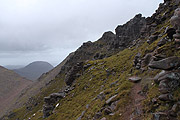
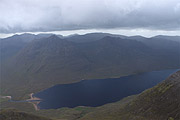
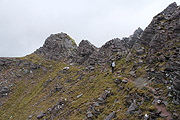
Since we made it onto Corrag Bhuidhe, I wanted to see myself to the very top. A scramble of a couple of metres from the bypass brought me to a cairn. To be precise - I stood on the north top of Corrag Bhuidhe, which is also the only cairned summit. I can find limited information on which pinnacle is the true Top. I thought that cairn should equate summit, but this isn't always the case. The horizon was obscured and it was difficult to take a height gauge along the other pinnacles. Who knows - maybe I haven't ticked the Munro Top at all? Anyway, that's for another day. The summit was an addition to the whole experience, a simple bonus. List-ticking gives structure to my hill-activates but no one should make the mistake in thinking it approaches all-encompassing.
Lord Berkeley's Seat is another great piece of rock. People talk about lords dangling legs over the edge. I scrambled up to find the true top a big wart of rock. The summit hangs above the corrie with astounding height and exposure. For this, it is one of the most magnificent Munro Tops. Luckily it isn't very exposed until the end. Nor do you need to scramble much, if at all. The ground is flat as it approaches the edge of the cliff, then dives to vertical in a clean 90 degree cut. I looked over the edge but dared not take a picture! This drop is so extreme that I found is almost incomprehensible. The gullies below twist downward, but it was difficult to understand in three dimensions. I nipped up to the top which required a little attention in the bad weather, and scrambled back down to meet the guys.





The Munros
What a day we'd had... We still hadn't touched the Munros yet. They were an anti-climax against the rugged beauty of Corrag Bhuidhe. We got views from Sgurr Fiona, which is a magnificent viewpoint. We had a break on the summit where I became cold enough that it took an hour or two to properly warm up again. The rain was becoming heavier and as we began climbing Bidein a' Ghlas Thuill - the highest of the An Teallach summits - the cloud closed in properly and we were denied any real mountain views for the remainder for the trip. This is a shame, because the classic An Teallach view is from this peak - the whole sweep through Sail Liath to climax in the fingers and set against the higher, triangular profile of Sgurr Fiona. I'm glad the SMC decided Sgurr Fiona was a Munro, it sure deserves that title.
And the quality of An Teallach of course lies in that 1-mile sweep. It was the highlight of our day. I think that mile of mountain architecture must make one of the best mountains in Scotland. I always thought that the features seemed insignificant from the road, at least compared against the great 'E'-shaped structure of An Teallach. But they mean everything. An Teallach is without a doubt one of the darkest and most atmospheric mountains around. Perhaps that has something to do with the weather we climbed it in. The cliffs are higher than those on Ben Nevis' North Face!
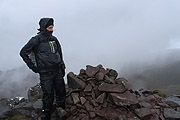
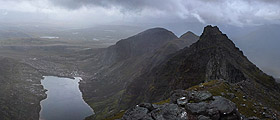
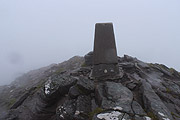
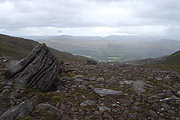
We reached Bidein a' Ghlas Thuill in thick mist and wind. Our day was mentally over and now the long walk to The Smiddy remained. We estimated the direction off the top because it seemed less hassle than getting the compass out. We were quickly proven correct and dropped down the northern corrie of the mountain - Coir' a' Mhuilinn.
Little stone men guided the way when the path became indistinct. The exposed bedrocks around here were fascinating and I wished I weren't so tired. Often the path would cross the bedrock upon which water flowed. A quick, solo, descent to the Smiddy brought me into warmth once more, where I changed clothes and dried off. Diane was cooking up a huge, delicious meal. The rest of the guys came in the door much later - I didn't realise I'd gone off so far ahead. It was a pleasant surprise to discover that the path was descended right above the Smiddy.
The following day, Dougie and I climbed A' Chailleach and Sgurr Breac in the Fannaichs. Having come off the back off An Teallach, the hills seemed of the 'tame' variety and the weather was certainly better too. We hitched a lift back to the Smiddy in the evening, and the moors of the Destitution Road showed the first signs of autumn.
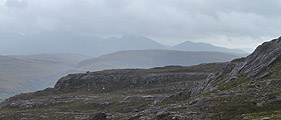
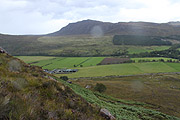
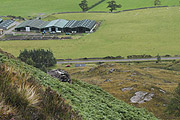
Times (Time relative to 0.00)
(0.00) 9.20am Dundonnell
(3.00) 12.20pm Sail Liath
(3.20) 12.40pm Stob Cadha Gobhlach
(4.50) 2.10pm Corrag Bhuidhe
(5.00) 2.20pm Lord Berkeley's Seat
(5.10) 2.30pm Sgurr Fiona
(6.00) 3.20pm Bidein a' Ghlas Thuill
(7.50) 5.10pm The Smiddy
(0.00) 9.20am Dundonnell
(3.00) 12.20pm Sail Liath
(3.20) 12.40pm Stob Cadha Gobhlach
(4.50) 2.10pm Corrag Bhuidhe
(5.00) 2.20pm Lord Berkeley's Seat
(5.10) 2.30pm Sgurr Fiona
(6.00) 3.20pm Bidein a' Ghlas Thuill
(7.50) 5.10pm The Smiddy
Written: 2011-09-13